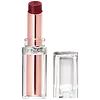What's inside
What's inside
 Key Ingredients
Key Ingredients

 Benefits
Benefits

 Concerns
Concerns

 Ingredients Side-by-side
Ingredients Side-by-side

Punica Granatum Extract
AstringentCanola Oil
EmollientSqualane
EmollientPentaerythrityl Tetraisostearate
EmollientBis-Behenyl/Isostearyl/Phytosteryl Dimer Dilinoleyl Dimer Dilinoleate
EmollientHelianthus Annuus Seed Cera
EmollientCaprylic/Capric Triglyceride
MaskingCandelilla Cera
EmollientTocopherol
AntioxidantAlumina
AbrasiveSynthetic Fluorphlogopite
Calcium Aluminum Borosilicate
Glycine Soja Oil
EmollientCalcium Sodium Borosilicate
Aluminum Hydroxide
EmollientSilica
AbrasiveCitronellol
PerfumingMagnesium Silicate
AbsorbentLimonene
PerfumingTin Oxide
AbrasivePunica Granatum Fruit Extract
AntioxidantGeraniol
PerfumingCI 77120
Cosmetic ColorantBenzyl Alcohol
PerfumingColophonium
Linalool
PerfumingCitric Acid
BufferingParfum
MaskingTitanium Dioxide
Cosmetic ColorantMica
Cosmetic ColorantCI 77491
Cosmetic ColorantCI 77492
Cosmetic ColorantCI 77499
Cosmetic ColorantCI 15850
Cosmetic ColorantCI 15985
Cosmetic ColorantCI 45380
Cosmetic ColorantCI 45410
Cosmetic ColorantCI 17200
Cosmetic ColorantCI 77742
Cosmetic ColorantCI 42090
Cosmetic ColorantCI 19140
Cosmetic ColorantCI 75470
Cosmetic ColorantCeramide AP
Skin ConditioningPunica Granatum Extract, Canola Oil, Squalane, Pentaerythrityl Tetraisostearate, Bis-Behenyl/Isostearyl/Phytosteryl Dimer Dilinoleyl Dimer Dilinoleate, Helianthus Annuus Seed Cera, Caprylic/Capric Triglyceride, Candelilla Cera, Tocopherol, Alumina, Synthetic Fluorphlogopite, Calcium Aluminum Borosilicate, Glycine Soja Oil, Calcium Sodium Borosilicate, Aluminum Hydroxide, Silica, Citronellol, Magnesium Silicate, Limonene, Tin Oxide, Punica Granatum Fruit Extract, Geraniol, CI 77120, Benzyl Alcohol, Colophonium, Linalool, Citric Acid, Parfum, Titanium Dioxide, Mica, CI 77491, CI 77492, CI 77499, CI 15850, CI 15985, CI 45380, CI 45410, CI 17200, CI 77742, CI 42090, CI 19140, CI 75470, Ceramide AP
Ricinus Communis Seed Oil
MaskingGlyceryl Triacetyl Ricinoleate
EmollientCetyl Ricinoleate
EmollientEuphorbia Cerifera Wax
Copernicia Cerifera Wax
Polyethylene
AbrasiveTocopheryl Acetate
AntioxidantPentaerythrityl Tetra-Di-T-Butyl Hydroxyhydrocinnamate
AntioxidantCI 77120
Cosmetic ColorantCI 19140
Cosmetic ColorantCI 42090
Cosmetic ColorantIron Oxides
CI 15850
Cosmetic ColorantMica
Cosmetic ColorantCI 75470
Cosmetic ColorantCI 77891
Cosmetic ColorantCI 45380
Cosmetic ColorantCI 73360
Cosmetic ColorantCI 15985
Cosmetic ColorantCI 77163
Cosmetic ColorantCI 17200
Cosmetic ColorantCI 45410
Cosmetic ColorantRicinus Communis Seed Oil, Glyceryl Triacetyl Ricinoleate, Cetyl Ricinoleate, Euphorbia Cerifera Wax, Copernicia Cerifera Wax, Polyethylene, Tocopheryl Acetate, Pentaerythrityl Tetra-Di-T-Butyl Hydroxyhydrocinnamate, CI 77120, CI 19140, CI 42090, Iron Oxides, CI 15850, Mica, CI 75470, CI 77891, CI 45380, CI 73360, CI 15985, CI 77163, CI 17200, CI 45410
 Reviews
Reviews

Ingredients Explained
These ingredients are found in both products.
Ingredients higher up in an ingredient list are typically present in a larger amount.
Ci 15850 is the pigment color red. It is an azo dye and created synthetically.
Azo dyes need to be thoroughly purified before use. This allows them to be more stable and longer-lasting.
This ingredient is common in foundations, lipsticks, and blushes. This color is described as brown/orangey red.
It has many secondary names such as Red 6 and Red 7. According to a manufacturer, Red 6 usually contains aluminum.
Learn more about CI 15850Ci 15985 is a dye made from petroleum. It is synthetically created and approved by the FDA for use in foods and cosmetics.
The color of this dye is orange/yellow.
This ingredient can be found in makeup, sun care, and skincare.
Learn more about CI 15985Ci 17200 is a synthetic reddish-purple dye.
CI 19140 is also known as Tartrazine. Tartrazine is a synthetic dye used in cosmetics, foods, and medicine to add a yellow color.
Tartrazine is created from petroleum and is water-soluble.
Some people may experience allergies from this dye, especially asthmatics and those with an aspirin intolerance.
Learn more about CI 19140Ci 42090 is a synthetic dye created from petroleum. It is used to give a bright blue color to cosmetics, medicine, and food.
Ci 45380 is a synthetic dye that comes from coal or tar sources. Due to this, it is often used in small quantities.
A common name for this dye is Red 22. Red 22 imparts a warm reddish color.
Similar to Red 27, this dye changes color based on pH and moisture levels.
This dye is colorless when dry but turns pink between pH levels 0.0 to ~3.0.
Learn more about CI 45380CI 45410 is a synthetic red-pigment and dye.
It often goes by both Red 28 or Red 27; manufacturers label both ingredients as CI 45410.
This dye is commonly found in makeup because it imparts a vivid color. Some types of this dye change color based on pH level and interaction with moisture:
Your skin has a natural pH of around 4.5 - 5.5.
According to the FDA, CI 45410 is not permitted for use in eye products.
Red 27 is a flourescein dye and commonly used as a fluorescent tracer in medicine.
Learn more about CI 45410Ci 75470 is a bright-red pigment. It is AKA carmine.
Carmine is derived from insects such as the cochineal beetle. This ingredient has been used as a natural dye for over 2000 years.
We don't have a description for CI 77120 yet.
Mica is a naturally occurring mineral used to add shimmer and color in cosmetics. It can also help improve the texture of a product or give it an opaque, white/silver color.
Serecite is the name for very fine but ragged grains of mica.
This ingredient is often coated with metal oxides like titanium dioxide. Trace amounts of heavy metals may be found in mica, but these metals are not harmful in our personal products.
Mica has been used since prehistoric times throughout the world. Ancient Egyptian, Indian, Greek, Roman, Aztec, and Chinese civilizations have used mica.
Learn more about Mica